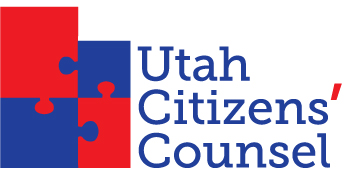The Utah Constitution vests power to legislate in the Utah legislature and the people of the state.[1] One way the co-equal power is demonstrated is the citizens’ right to pass a new law if a majority of registered voters approves it in a ballot initiative. The Utah Constitution states that an initiative is adopted when a majority of voters pass the initiative at a designated general election.[2]
Procedures for gathering sufficient signatures to place an initiative on the ballot are established by the Utah Legislature. Arguably, the process should be quite difficult because no one wants any group of disgruntled citizens to easily get an initiative on the ballot. The Utah Legislature, however, has made it increasingly difficult in recent years, even more so after three initiatives succeeded in being passed in 2018. Utah requires that signatures on an initiative petition total 8% of voters who were registered to vote on January 1st of the year preceding the initiative. The total must be reached statewide and also in each of at least 26 of the 29 state Senate Districts.
The number of signatures needed, their required distribution across a super-majority of 26 of 29 state Senate districts, and the timelines for collecting and submitting signatures have made Utah’s requirements among the toughest in the nation.[3] Utah legislators frequently complain about California’s initiative requirements and have used them as a fear tactic to continually justify Utah’s requirements. This is a ruse: Utah is not like California, which has among the easiest requirements in the country. No one is suggesting that Utah’s requirements should be that easy—e.g., requiring signatures equal to only 5% of the votes cast for Governor in the last election without any distribution by geographic region.[4]
A few of Utah’s more recent statutory requirements that intimidate and harass initiative sponsors are the following:
- Each signer must attest in writing to having read and understood the proposed law. Additionally, each signature gatherer must wait for the individual to read the entire initiative before signing it and attest in writing to having done so.[5] With UCC’s help, a 2024 bill is expected to be introduced to delete the requirement that each signer “understand” what they read. A separate bill is expected to be introduced to delete the requirement that a signer must read the entire initiative before signing a petition. Reading an executive summary would be substituted. Both should be passed.
- Sponsors now must pay for uniformly formatted identification badges for all paid signature gatherers and pay them by the hour, obviously onerous if gatherers must wait for signers to read the entire initiative.[6]
- All signatures must be turned in no later than February 15th of the general election year ballot, rather than the prior deadline of April 15th.[7]
In 2023, a proposed amendment to the Utah Constitution that failed to pass would have required that any initiative with a tax increase or tax rate increase must pass by 60% of the voters, i.e., a super-majority.[8] The Legislature does not ask this of itself when it passes tax rate increases. Such a super-majority gives 40.1% of the voters the ability to stop any initiative supported by 59.9% of the voters. It violates the current Utah Constitution that honors majority rule for initiative passage.
Achieving super-majorities on policy issues of high significance is virtually impossible these days. For instance, the slight increase in the tax rate that paid for Medicaid Expansion was passed by 53% of the voters in 2018 [9] and is considered a significant win for thousands of low-income families in Utah lacking health care access. Similar Medicaid expansions under the Affordable Care Act have now been enacted in 40 of the states, plus the District of Columbia.[10] A 60% requirement would have led to defeat of this important initiative in Utah.
An overriding concern regarding Utah’s initiative process, of course, is the existing ability of the legislature to directly “repeal and replace” a citizen initiative once it has passed – effectively disregarding the people’s power to enact law. The 2019 Legislature did just that after 2018 passage of the initiative to create an Independent Redistricting Commission to draw nonpartisan maps for legislative districts. The Legislature stripped language establishing essential redistricting standards and severely limited the Commission’s role. This action sanctioning continued partisan gerrymandering was a direct challenge to the people’s initiative power. A Utah Supreme Court ruling on the constitutionality of the Legislature’s actions is pending, with implications for how power should be shared between the people and the Legislature.
Should Utah Voters Support Efforts to Strengthen the Ability of the People to Share Power with the Legislature? The answer is a resounding YES.
_______________________________________________________
[1] Utah Constitution, Article VI, Section 1(b). https://le.utah.gov/xcode/Articlevi/Article_VI,_Section_1.html?v=UC_AVI_S1_1800010118000101
[2] Utah Constitution, Article VI, Section 1(2((a). Ibid.
[3] https://ballotpedia.org/Laws_governing_the_initiative_process_in_Utah . These days, to even have a possibility of success requires other considerations beyond legal requirements, i.e., strong organizational capacity, many volunteers, and large amounts of money.
[4] https://ballotpedia.org/Laws_governing_the_initiative_process_in_California
[5] Utah Code 20A-7-104(6)(a); 20A-7-203(4). https://le.utah.gov/xcode/Title20A/Chapter7/20A-7-S104.html
[6] Utah Code 20A-7-104(4). Ibid.
[7] Utah Code 20A-105(5)(a)(i)(C). https://le.utah.gov/xcode/Title20A/Chapter7/20A-7-S105.html
[8] House Jt. Resolution 17 (2023) (not passed). https://le.utah.gov/~2023/bills/static/HJR017.html
[9] https://ballotpedia.org/Utah_Proposition_3,_Medicaid_Expansion_Initiative_(2018)
[10] https://www.kff.org/medicaid/issue-brief/status-of-state-medicaid-expansion-decisions-interactive-map/
